

View.email.kqed. In every classroom, teachers try to engage students who have a variety of temperaments: extroverts, introverts and ambiverts.

They work with children who crave sensory stimulation and with those who are highly sensitive to noise and visual distraction. While one temperament is not better than any other, introverted students are often “overlooked, undervalued and overstimulated in our schools,” said Heidi Kasevich, a 20-year teaching veteran and director of education for Quiet Revolution, an outgrowth of Susan Cain’s best-selling book on the power of introverts.
When Kasevich was a student, she was often told, “Just come out of your shell” and “Just speak up.” “I had no idea I had an inborn temperament,” she said, “and I often felt unsafe in school environments.” A person’s basic temperament is rooted in biology, with differences emerging in infancy and early childhood . What Do Teachers Need to Know About Introverted Students? Six Classroom Strategies that Help Introverts Thrive. Mchssocialstudies [licensed for non-commercial use only] / MCHS Social Studies - Summer 2017. The resources included in this workspace have been gathered from professional work at the secondary and college level as well as the GaDOE.
![mchssocialstudies [licensed for non-commercial use only] / MCHS Social Studies - Summer 2017](http://cdn.pearltrees.com/s/pic/th/mchssocialstudies-commercial-176245110)
The space is editable and intended for use by your department as you see fit. Use the SIDEBAR to navigate among pages on the site --> GCSS Web Site. How Social Studies Can Help Young Kids Make Sense of the World. Revisiting Reagan's 'A Nation at Risk' Report 35 Years Later. A Collection of Resources for Teaching Social Justice. Method in Social Studies. Tools of the Historian. Middle School Social Studies: Resources for Students, Teachers and Parents.
Social Studies Web Sites for Teachers. Go Back: Virtual Middle School Library Home / Resources for Teachers and Parents Menu / Social Studies Social Studies Menu: General Sites | Current Events | Geography | Government | History - General | History - United States | History - Pennsylvania | History - World General Sites.
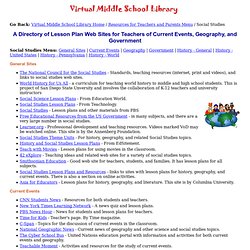
Middle School Social Studies: Teaching Resources for Middle School Social Studies. Practical Tools for Teaching News Literacy. The Center for News Literacy has partnered with Intermediate School 303, a public middle school in New York City, to help the school implement a cross-curricular news literacy program.
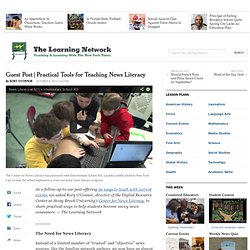
As a follow-up to our post offering 50 ways to teach with current events, we asked Rory O’Connor, director of the Digital Resource Center at Stony Brook University’s Center for News Literacy, to share practical ways to help students become savvy news consumers. — The Learning Network The Need for News Literacy Instead of a limited number of “trusted” and “objective” news sources, like the familiar network anchors, we now have an almost limitless number of outlets on the Internet and TV. In fact, anyone can publish a blog or tweet. Taking the Struggle Out of Group Work. A MiddleWeb Blog by Jody Passanisi & Shara Peters Most history and social studies teachers understand the value of group work, especially now, in the era of collaborative learning.
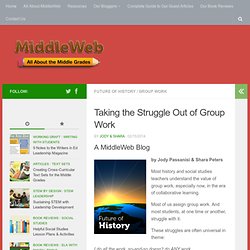
Most of us assign group work. And most students, at one time or another, struggle with it. These struggles are often universal in theme: I do all the work, so-and-so doesn’t do ANY work. I don’t like working with ______. I want to work with ____ instead. What’s going on here? How we help groups work together. ArticlePace. 15 places with fun and engaging social studies games. National Archives Games The British National Archives website has a nice selection of history themed games that you won't likely find elsewhere.
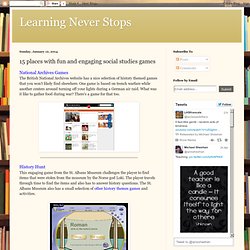
One game is based on trench warfare while another centers around turning off your lights during a German air raid. What was it like to gather food during war? There's a game for that too. History Hunt This engaging game from the St. Albans Museum challenges the player to find items that were stolen from the museum by the Norse god Loki. Washington Crossing the Delaware This simple game from the New Jersey State website challenges the player to guide George Washington across the icy Delaware River. BBC History Games This selection of games comes from the BBC and focuses on British History. Mission U.S.
Mr. National Geographic's Geography Games National Geographic has over 120 games based around geography, history, science and nature. H.I.P. Kindergarten Historians: Primary Sources in an Early Elementary Classroom. This post is co-authored by the Library of Congress Teacher in Residence, Earnestine Sweeting and a Library of Congress 2011 Summer Teacher Institute participant, Teresa St.
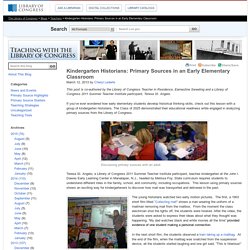
Angelo. If you’ve ever wondered how early elementary students develop historical thinking skills, check out this lesson with a group of kindergarten historians. The Class of 2025 demonstrated their educational readiness while engaged in analyzing primary sources from the Library of Congress. Discussing primary sources with an adult Teresa St. Motion picture discussion The young historians watched two early motion pictures. In the next short film, the students observed a train taking up a mailbag. Identifying evidence in historic photographs.
Jefferson students turning hard lessons into service project. 21 YouTube videos that help make learning the Constitution fun. The Articles of Confederation and the Constitution This terrific 13 minute video from the people over at Crash Course.
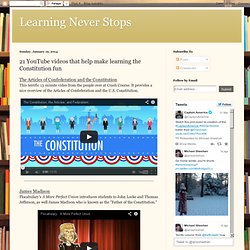
It provides a nice overview of the Articles of Confederation and the U.S. Constitution. James Madison Flocabulary's A More Perfect Union introduces students to John Locke and Thomas Jefferson, as well James Madison who is known as the "Father of the Constitution. " Preamble When discussing the Preamble here are a couple a videos from classic television shows.
Whether or not you are a fan of the original Star Trek series, this speech by Captain Kirk gets to the heart of the Constitution when he says, "It must apply to everyone, or it means nothing! " The History 2.0 Classroom. American Centuries: History and Art from New England. Learning Never Stops: American Centuries - Interactive Online Museum. Sir Ken Robinson's New TED Talk About 'Education's Death Valley' The Modern Taxonomy Wheel. Assessment Creator. Used by teachers and students during instruction to provide feedback to adjust ongoing teaching and learning to improve students’ achievement of intended instructional outcomes.
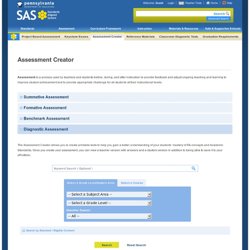
CCSSO(2008) contextualizes formative assessment as follows: Formative assessment is a process used by teachers and students during instruction that provides feedback to adjust ongoing teaching and learning to improve students’ achievement of intended instructional outcomes. The primary purpose of the formative assessment process, as conceived in this definition, is to provide evidence that is used by teachers and students to inform instruction and learning during the teaching/learning process.
Effective formative assessment involves collecting evidence about how student learning is progressing during the course of instruction so that necessary instructional adjustments can be made to close the gap between students’ current understanding and the desired goals. The key is how the results are used.